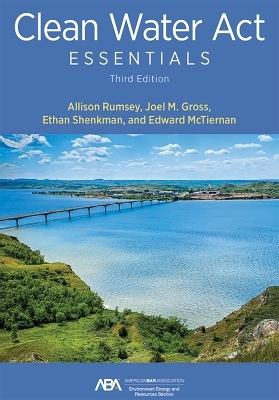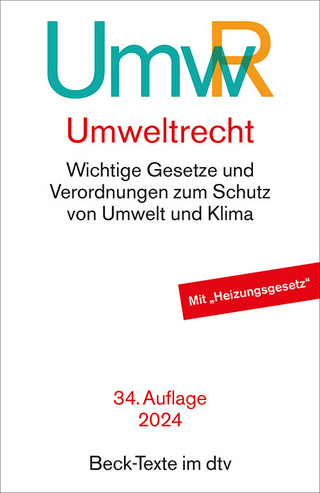
Clean Water Act Essentials, Third Edition
American Bar Association (Verlag)
978-1-63905-217-2 (ISBN)
Pollution Control Act, commonly known as the Clean Water Act--the primary
federal statute regulating water pollution for the protection of the country's
water resources.
Clean Water Act Essentials: Third Edition provides
legal practitioners, consultants, and other interested individuals with an
overview of the CWA's complex framework of federal and state controls. The
authors explain the statute and the 1972 Amendments that created a system of
permits and regulations to govern the discharge of pollutants into the nation's
waters and publicly owned treatment works, focusing on these uniform standards
and their implementation and enforcement.
This quick overview covers all essential elements of the Clean
Water Act:
History of the
Clean Water Act and Amendments
NPDES
permitting process
Technology-based
standards
Water-quality-based
effluent limitations
Publicly owned
treatment works (POTW)
Regulation of
wetlands
Discharges and
spills of oil and hazardous substances
Wet-weather
discharges from point sources
Reducing
nonpoint source pollution
Enforcement
Clean Water Act Essentials: Third Edition includes
time-saving appendices, including an acronym list, FAQs, a list of key cases
with a one-sentence description of that case, glossary, and bibliography.
Whether you're new or seasoned professional, you'll find this a quick and
necessary resource for understanding the legal fundamentals of the CWA.
Allison Rumsey is a partner in the Washington, D.C., office of Arnold & Porter, and is a member of the firm’s Environmental Practice Group. She represents clients in state and federal regulatory enforcement actions, class action and citizen suit lawsuits, and business disputes. She represented BP in the Deepwater Horizon matter as it related to government enforcement under the Clean Water Act and Oil Pollution Act. She also represents a shipping company in the Huntington Bay oil spill. Allison also assists clients in navigating and, where there is litigation defending, the permitting process under the environmental laws applicable to large infrastructure and other projects. Prior to joining the firm, she was Counsel to the Assistant Attorney General, Environment and Natural Resources Division of the U.S. Department of Justice Ethan Shenkman is a partner in the Washington, D.C., office of Arnold & Porter, and is a member of the firm’s Environmental Practice Group. Nationally known for his work with climate change policy and energy transition, he advises on renewable fuels, carbon capture and sequestration, methane regulation, the phaseout of HFCs, and renewable energy permitting. He also regularly represents clients in trial and appellate court, and in regulatory matters before federal and state agencies. Prior to joining the firm, he served as Deputy General Counsel at the EPA and, prior to that, as Deputy Assistant Attorney General at the Environment and Natural Resources Division of the U.S. Department of Justice. Joel Gross is a senior counsel in the Washington, D.C., office of Arnold & Porter, and is a member of the firm’s Environmental Practice Group. Joel represents and advises clients in litigation and nonlitigation matters under federal and state environmental laws, with a special emphasis on compliance and enforcement issues. Prior to joining Arnold & Porter, he was chief of the Environmental Enforcement Section of the U.S. Department of Justice, where he handled and supervised many Clean Water Act matters. He also worked with EPA on policy and legislative initiatives related to the Clean Water Act. Ed McTiernan is a partner in the New York office of Arnold & Porter, and is a member of the firm’s Environmental Practice Group. He is an environmental litigator who focuses on state and federal regulatory issues, including site remediation, Brownfield redevelopment, natural resource damages, energy and infrastructure projects, as well as wastewater and stormwater permitting and defense of enforcement proceedings. Prior to joining the firm, he served as the Deputy Commissioner and General Counsel at the New York State Department of Environmental Conservation.
iii
About the Authors vii
1 Executive Summary 1
2 The History of the Clean Water Act 5
2.1 Foundations of the Modern Act 5
2.2 The 1972 Amendments: The New Clean Water Act 7
2.3 The 1977 Amendments 10
2.4 The 1987 Amendments 10
2.5 The Oil Pollution Act of 1990 11
2.6 Nonlegislative Developments 12
2.7 The Clean Water Act at 50 14
3 General Prohibition of Discharges 17
3.1 Introduction 17
3.2 The Prohibition Defined 17
3.3 Discharges to Navigable Waters through Groundwater 29
3.4 Exceptions to the Prohibition 30
4 National Pollutant Discharge Elimination System
(NPDES) Overview 31
4.1 The NPDES Process 31
4.2 Exceptions to the NPDES Process 32
4.3 NPDES Administration 33
4.4 Applying for a Permit 36
4.5 Elements of a Permit 38
4.6 Section 401 Water Quality Certifications 41
4.7 Review of Permit Decisions 42
5 Technology-Based Standards 45
5.1 Introduction 45
5.2 The Range of Technology-Based Standards 47
5.3 Setting Effluent Limits 52
5.4 “Fundamentally Different Factors” (FDF) Variance 54
5.5 BAT Variances 56
6 Water Quality–Based Effluent Limitations 57
6.1 Introduction 57
6.2 History and Purpose of Water Quality-Based Effluent Limits 58
6.3 Establishing Water Quality-Based Effluent Limits (WQBELs) 59
6.4 Water Quality Trading Policy of 2003 67
7 Regulations of Publicly Owned Treatment Works 69
7.1 Introduction 69
7.2 Regulation of Discharges from POTWs 71
7.3 Regulation of Discharges to POTWs: Pretreatment Standards 76
7.4 Substantive Requirements of Pretreatment Program 80
7.5 POTW Pretreatment Program Variances and Removal Credits 82
7.6 Collection System Challenges 83
8 Regulation of Wetlands 85
8.1 Introduction 85
8.2 Jurisdictional Issues 87
8.3 Definitional Issues and Scope 88
8.4 Section 404 Permitting Process 92
8.5 Noncompliance and Enforcement 99
8.6 Challenges to Corps Determinations 100
9 Discharges and Spills of Oil and Hazardous Substances 103
9.1 Introduction 103
9.2 Section 311(b)(3): The Prohibition of Discharges 104
9.3 Notice Requirements for Oil and Hazardous Substance Spills 107
9.4 The Consequences of a Prohibited Discharge 108
9.5 The Prevention of Prohibited Oil Discharges 111
9.6 A Summary of OPA 112
10 Wet-Weather Discharges from Point Sources 115
10.1 Regulation of Stormwater 115
10.2 Application Requirements 123
10.3 Combined Sewer Overflows 124
10.4 Sanitary Sewer Overflows 126
10.5 Integrated Planning 127
11 Reducing Nonpoint Source Pollution 129
11.1 Introduction 129
11.2 Nonpoint Source of Pollution 131
11.3 Nonpoint Source Pollution Addressed in the Clean Water Act 132
11.4 Coastal Zone Act Reauthorization Amendments of 1990 135
12 Enforcement 137
12.1 Introduction 137
12.2 Criminal Enforcement 137
12.3 Civil Enforcement 140
12.4 Administrative Enforcement 146
12.5 Emergency Authorities 147
12.6 State Enforcement 148
12.7 Citizen Suits 149
12.8 Defenses against Enforcement 152
Table of Cases 155
Index 161
| Erscheinungsdatum | 04.04.2023 |
|---|---|
| Zusatzinfo | Illustrations |
| Verlagsort | Chicago, IL |
| Sprache | englisch |
| Maße | 152 x 228 mm |
| Themenwelt | Recht / Steuern ► EU / Internationales Recht |
| Recht / Steuern ► Öffentliches Recht ► Umweltrecht | |
| ISBN-10 | 1-63905-217-8 / 1639052178 |
| ISBN-13 | 978-1-63905-217-2 / 9781639052172 |
| Zustand | Neuware |
| Haben Sie eine Frage zum Produkt? |
aus dem Bereich


